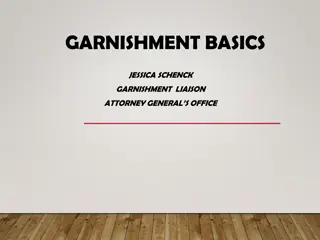
Dynamic Memory Allocation in Computer Systems
Explore the concepts of dynamic memory allocation in computer systems, including its importance, error causes, and memory management techniques. Learn about memory allocation types, application usage, and the role of allocators. Discover how programmers can utilize dynamic memory allocation for efficient resource management in software development.
Download Presentation

Please find below an Image/Link to download the presentation.
The content on the website is provided AS IS for your information and personal use only. It may not be sold, licensed, or shared on other websites without obtaining consent from the author. If you encounter any issues during the download, it is possible that the publisher has removed the file from their server.
You are allowed to download the files provided on this website for personal or commercial use, subject to the condition that they are used lawfully. All files are the property of their respective owners.
The content on the website is provided AS IS for your information and personal use only. It may not be sold, licensed, or shared on other websites without obtaining consent from the author.
E N D
Presentation Transcript
Carnegie Mellon 14-513 18 18- -613 613 1 Bryant and O Hallaron, Computer Systems: A Programmer s Perspective, Third Edition
Carnegie Mellon Dynamic Memory Allocation: Basic Concepts 18-213/18-613: Introduction to Computer Systems 14th Lecture, October 13th, 2022 2 Bryant and O Hallaron, Computer Systems: A Programmer s Perspective, Third Edition
Carnegie Mellon Understanding this Error What causes this error? Why does it matter? $ ./mm-corrupt *** Error in `./mm-corrupt': free(): invalid next size (fast): 0x0000000000ffe010 *** ======= Backtrace: ========= /lib/x86_64-linux-gnu/libc.so.6(+0x777f5)[0x7f043efe67f5] /lib/x86_64-linux-gnu/libc.so.6(+0x8038a)[0x7f043efef38a] /lib/x86_64-linux-gnu/libc.so.6(cfree+0x4c)[0x7f043eff358c] ./mm-corrupt[0x400795] /lib/x86_64-linux-gnu/libc.so.6(__libc_start_main+0xf0)[0x7f043ef8f840] ./mm-corrupt[0x400629] ======= Memory map: ======== ... 3 Bryant and O Hallaron, Computer Systems: A Programmer s Perspective, Third Edition
Carnegie Mellon Today Basic concepts CSAPP 9.9.1 - 9.9.5 CSAPP 9.9.6 - 9.9.12 Implicit free lists 4 Bryant and O Hallaron, Computer Systems: A Programmer s Perspective, Third Edition
Carnegie Mellon Dynamic Memory Allocation Memory invisible to user code Application Kernel virtual memory User stack (created at runtime) Dynamic Memory Allocator %rsp (stack pointer) Heap Programmers use dynamic memory allocators (such as malloc) to acquire virtual memory (VM) at run time. for data structures whose size is only known at runtime Memory-mapped region for shared libraries brk Run-time heap (created by malloc) Loaded from the executable file Read/write segment (.data, .bss) Dynamic memory allocators manage an area of process VM known as the heap. Read-only segment (.init, .text, .rodata) 0x400000 Unused 5 0 Bryant and O Hallaron, Computer Systems: A Programmer s Perspective, Third Edition
Carnegie Mellon Dynamic Memory Allocation Allocator maintains heap as collection of variable sized blocks, which are either allocated or free Types of allocators Explicit allocator: application allocates and frees space E.g., malloc and free in C Implicit allocator: application allocates, but does not free space E.g., new and garbage collection in Java Will discuss simple explicit memory allocation today 6 Bryant and O Hallaron, Computer Systems: A Programmer s Perspective, Third Edition
Carnegie Mellon The malloc Package #include <stdlib.h> void *malloc(size_t size) Successful: Returns a pointer to a memory block of at least size bytes aligned to a 16-byte boundary (on x86-64) If size == 0, returns NULL Unsuccessful: returns NULL (0) and sets errno toENOMEM void free(void *p) Returns the block pointed at by p to pool of available memory p must come from a previous call to malloc, calloc, or realloc Other functions calloc: Version of malloc that initializes allocated block to zero. realloc: Changes the size of a previously allocated block. sbrk: Used internally by allocators to grow or shrink the heap 7 Bryant and O Hallaron, Computer Systems: A Programmer s Perspective, Third Edition
Carnegie Mellon malloc Example #include <stdio.h> #include <stdlib.h> void foo(long n) { long i, *p; /* Allocate a block of n longs */ p = (long *) malloc(n * sizeof(long)); if (p == NULL) { perror("malloc"); exit(0); } /* Initialize allocated block */ for (i=0; i<n; i++) p[i] = i; /* Do something with p */ . . . /* Return allocated block to the heap */ free(p); } 8 Bryant and O Hallaron, Computer Systems: A Programmer s Perspective, Third Edition
Carnegie Mellon Sample Implementation Code File mm-reference.c Manages fixed size heap Functions mm_malloc, mm_free Features Based on words of 8-bytes each Pointers returned by malloc are double-word aligned Double word = 2 words Compile and run tests with command interpreter 9 Bryant and O Hallaron, Computer Systems: A Programmer s Perspective, Third Edition
Carnegie Mellon Visualization Conventions Show 8-byte words as squares Allocations are double-word aligned. Allocated block (4 words) Free block (2 words) Free word Allocated word 10 Bryant and O Hallaron, Computer Systems: A Programmer s Perspective, Third Edition
Carnegie Mellon Allocation Example (Conceptual) #define SIZ sizeof(size_t) p1 = malloc(4*SIZ) p2 = malloc(5*SIZ) p3 = malloc(6*SIZ) free(p2) p4 = malloc(2*SIZ) 11 Bryant and O Hallaron, Computer Systems: A Programmer s Perspective, Third Edition
Carnegie Mellon Constraints Applications Can issue arbitrary sequence of malloc and free requests free request must be to a malloc d block Explicit Allocators Can t control number or size of allocated blocks Must respond immediately to mallocrequests i.e., can t reorder or buffer requests Must allocate blocks from free memory i.e., can only place allocated blocks in free memory Must align blocks so they satisfy all alignment requirements 16-byte (x86-64) alignment on 64-bit systems Can manipulate and modify only free memory Can t move the allocated blocks once they are malloc d i.e., compaction/defragmention is not allowed. Why not? 12 Bryant and O Hallaron, Computer Systems: A Programmer s Perspective, Third Edition
Carnegie Mellon Performance Goal: Throughput Given some sequence of malloc and free requests: R0, R1, ..., Rk, ... , Rn-1 Goals: maximize throughput and peak memory utilization These goals are often conflicting Throughput: Number of completed requests per unit time Example: 5,000 malloc calls and 5,000 freecalls in 10 seconds Throughput is 1,000 operations/second 13 Bryant and O Hallaron, Computer Systems: A Programmer s Perspective, Third Edition
Carnegie Mellon Performance Goal: Minimize Overhead Given some sequence of malloc and free requests: R0, R1, ..., Rk, ... , Rn-1 Def: Aggregate payload Pk malloc(p) results in a block with a payload of p bytes After request Rk has completed, the aggregate payload Pk is the sum of currently allocated payloads Def: Current heap size Hk Assume Hk is monotonically nondecreasing i.e., heap only grows when allocator uses sbrk Def: Overhead after k+1 requests Fraction of heap space NOT used for program data Ok= Hk/ (maxi k Pi ) 1.0 14 Bryant and O Hallaron, Computer Systems: A Programmer s Perspective, Third Edition
Carnegie Mellon Benchmark Example Step 1 2 3 4 5 6 7 8 9 10 11 12 13 14 15 16 17 18 19 20 Command a 0 9904 a 1 50084 a 2 20 a 3 16784 f 3 a 4 840 a 5 3244 f 0 a 6 2012 f 2 a 7 33856 f 1 a 8 136 f 7 f 6 a 9 20 f 4 f 8 f 5 f 9 Delta 9904 50084 Allocated Peak Benchmark syn-array-short Trace provided with malloc lab Allocate & free 10 blocks a = allocate f = free Bias toward allocate at beginning & free at end Blocks numbered 0 9 Allocated: Sum of all allocated amounts Peak: Max so far of Allocated 9904 59988 60008 76792 60008 60848 64092 54188 56200 56180 90036 39952 40088 6232 4220 4240 3400 3264 9904 59988 60008 76792 76792 76792 76792 76792 76792 76792 90036 90036 90036 90036 90036 90036 90036 90036 90036 90036 20 16784 -16784 840 3244 -9904 2012 -20 33856 -50084 136 -33856 -2012 20 -840 -136 -3244 -20 20 0 15 Bryant and O Hallaron, Computer Systems: A Programmer s Perspective, Third Edition
Carnegie Mellon Benchmark Visualization 1 Step 1 2 3 4 5 6 7 8 9 10 11 12 13 14 15 16 17 18 19 20 Command a 0 9904 a 1 50084 a 2 20 a 3 16784 f 3 a 4 840 a 5 3244 f 0 a 6 2012 f 2 a 7 33856 f 1 a 8 136 f 7 f 6 a 9 20 f 4 f 8 f 5 f 9 Delta Allocated Peak 9904 50084 9904 59988 60008 76792 60008 60848 64092 54188 56200 56180 90036 39952 40088 6232 4220 4240 3400 3264 9904 59988 60008 76792 76792 76792 76792 76792 76792 76792 90036 90036 90036 90036 90036 90036 90036 90036 90036 90036 0.9 0.8 Normalized Memory Used 20 0.7 16784 -16784 840 3244 -9904 2012 0.6 0.5 0.4 0.3 -20 0.2 33856 -50084 136 -33856 -2012 0.1 0 0 0.2 0.4 0.6 0.8 1 Normalized Operation Number 20 Data Data Fit -840 -136 -3244 -20 20 Data line shows total allocated data ( Pi ) Data Fit line shows peak of total (maxi k Pi ) Normalized in X & Y 0 16 Bryant and O Hallaron, Computer Systems: A Programmer s Perspective, Third Edition
Carnegie Mellon Full Benchmark Behavior 1.4 1.2 1.0 Memory Used / Peak Data 0.8 Data Fit Data 0.6 0.4 0.2 0.0 0 0.1 0.2 0.3 0.4 0.5 0.6 0.7 0.8 0.9 1 Operation / Operation Count Given sequence of mallocs & frees (40,000 blocks) Starts with all mallocs, and shifts toward all frees Manage space for all allocated blocks Metrics Data: Pi Data fit: maxi k Pi 17 Bryant and O Hallaron, Computer Systems: A Programmer s Perspective, Third Edition
Carnegie Mellon Fragmentation Poor memory utilization caused by fragmentation internal fragmentation external fragmentation 18 Bryant and O Hallaron, Computer Systems: A Programmer s Perspective, Third Edition
Carnegie Mellon Internal Fragmentation For a given block, internal fragmentation occurs if payload is smaller than block size Block Internal fragmentation Internal fragmentation Payload Caused by Overhead of maintaining heap data structures Padding for alignment purposes Explicit policy decisions (e.g., to return a big block to satisfy a small request) Depends only on the pattern of previous requests Thus, easy to measure 19 Bryant and O Hallaron, Computer Systems: A Programmer s Perspective, Third Edition
Carnegie Mellon Internal Fragmentation Effect 1.4 1.2 1.0 Memory Used / Peak Data 0.8 Perfect Fit Data Fit 0.6 Data 0.4 0.2 0.0 0 0.1 0.2 0.3 0.4 0.5 0.6 0.7 0.8 0.9 1 Operation / Operation Count Perfect Fit: Only requires space for allocated data, data structures, and unused space due to alignment constraints For this benchmark, 1.5% overhead Cannot achieve in practice Especially since cannot move allocated blocks 20 Bryant and O Hallaron, Computer Systems: A Programmer s Perspective, Third Edition
Carnegie Mellon #define SIZ sizeof(size_t) External Fragmentation Occurs when there is enough aggregate heap memory, but no single free block is large enough p1 = malloc(4*SIZ) p2 = malloc(5*SIZ) p3 = malloc(6*SIZ) free(p2) Yikes! (what would happen now?) p4 = malloc(7*SIZ) Amount of external fragmentation depends on the pattern of future requests Thus, difficult to measure 21 Bryant and O Hallaron, Computer Systems: A Programmer s Perspective, Third Edition
Carnegie Mellon External Fragmentation Effect 1.4 1.2 1.0 Memory Used / Peak Data 0.8 Best Fit Perfect Fit Data Fit 0.6 Data 0.4 0.2 0.0 0 0.1 0.2 0.3 0.4 0.5 0.6 0.7 0.8 0.9 1 Operation / Operation Count Best Fit: One allocation strategy (To be discussed later) Total overhead = 8.3% on this benchmark 22 Bryant and O Hallaron, Computer Systems: A Programmer s Perspective, Third Edition
Carnegie Mellon Implementation Issues How do we know how much memory to free given just a pointer? How do we keep track of the free blocks? What do we do with the extra space when allocating a structure that is smaller than the free block it is placed in? How do we pick a block to use for allocation -- many might fit? How do we reuse a block that has been freed? 23 Bryant and O Hallaron, Computer Systems: A Programmer s Perspective, Third Edition
Carnegie Mellon Knowing How Much to Free Standard method Keep the length (in bytes) of a block in the word preceding the block. Including the header This word is often called the header fieldorheader Requires an extra word for every allocated block p0 p0 = malloc(4*SIZ) 48 block size Payload (aligned) Padding (for alignment) free(p0) 24 Bryant and O Hallaron, Computer Systems: A Programmer s Perspective, Third Edition
Carnegie Mellon Keeping Track of Free Blocks Method 1: Implicit list using length links all blocks Need to tag each block as allocated/free Unused 32 16 48 32 Method 2: Explicit list among the free blocks using pointers Need space for pointers 32 16 48 32 Method 3: Segregated free list Different free lists for different size classes Method 4: Blocks sorted by size Can use a balanced tree (e.g. Red-Black tree) with pointers within each free block, and the length used as a key 25 Bryant and O Hallaron, Computer Systems: A Programmer s Perspective, Third Edition
Carnegie Mellon Today Basic concepts Implicit free lists 26 Bryant and O Hallaron, Computer Systems: A Programmer s Perspective, Third Edition
Carnegie Mellon Method 1: Implicit Free List For each block we need both size and allocation status Could store this information in two words: wasteful! Standard trick When blocks are aligned, some low-order address bits are always 0 Instead of storing an always-0 bit, use it as an allocated/free flag When reading the Size word, must mask out this bit 1 word a = 1: Allocated block a = 0: Free block Size a Format of allocated and free blocks Size: total block size Payload Payload: application data (allocated blocks only) Optional padding 27 Bryant and O Hallaron, Computer Systems: A Programmer s Perspective, Third Edition
Carnegie Mellon Detailed Implicit Free List Example End Block Unused Start of heap 16/0 32/1 64/0 32/1 8/1 heap_end heap_start Allocated blocks: shaded Free blocks: unshaded Headers: labeled with size in words/allocated bit Headers are at non-aligned positions Payloads are aligned Double-word aligned 28 Bryant and O Hallaron, Computer Systems: A Programmer s Perspective, Third Edition
Carnegie Mellon Implicit List: Data Structures header payload Block declaration typedef uint64_t word_t; typedef struct block { word_t header; unsigned char payload[0]; } block_t; // Zero length array // block_t *block Getting payload from block pointer return (void *) (block->payload); Getting header from payload // bp points to a payload return (block_t *) ((unsigned char *) bp - offsetof(block_t, payload)); C function offsetof(struct, member) returns offset of member within struct 29 Bryant and O Hallaron, Computer Systems: A Programmer s Perspective, Third Edition
Carnegie Mellon Implicit List: Header access Size a Getting allocated bit from header return header & 0x1; Getting size from header return header & ~0xfL; // block_t *block Initializing header block->header = size | alloc; 30 Bryant and O Hallaron, Computer Systems: A Programmer s Perspective, Third Edition
Carnegie Mellon Implicit List: Traversing list header payload unused header payload block size Find next block static block_t *find_next(block_t *block) { return (block_t *) ((unsigned char *) block + get_size(block)); } End Block Unused 16/0 32/1 64/0 32/1 8/1 31 Bryant and O Hallaron, Computer Systems: A Programmer s Perspective, Third Edition
Carnegie Mellon Implicit List: Finding a Free Block First fit: Search list from beginning, choose first free block that fits: Finding space for asize bytes (including header): static block_t *find_fit(size_t asize) { block_t *block; for (block = heap_start; block != heap_end; block = find_next(block)) { { if (!(get_alloc(block)) && (asize <= get_size(block))) return block; } return NULL; // No fit found } heap_start heap_end 16/0 32/1 64/0 32/1 8/1 32 Bryant and O Hallaron, Computer Systems: A Programmer s Perspective, Third Edition
Carnegie Mellon Implicit List: Finding a Free Block First fit: Search list from beginning, choose first free block that fits: Can take linear time in total number of blocks (allocated and free) In practice it can cause splinters at beginning of list Next fit: Like first fit, but search list starting where previous search finished Should often be faster than first fit: avoids re-scanning unhelpful blocks Some research suggests that fragmentation is worse Best fit: Search the list, choose the best free block: fits, with fewest bytes left over Keeps fragments small usually improves memory utilization Will typically run slower than first fit Still a greedy algorithm. No guarantee of optimality 33 Bryant and O Hallaron, Computer Systems: A Programmer s Perspective, Third Edition
Carnegie Mellon Comparing Strategies 1.4 1.2 1.0 Memory Used / Peak Data 0.8 Next Fit First Fit Best Fit Perfect Fit 0.6 Data Fit Data 0.4 0.2 0.0 0 0.1 0.2 0.3 0.4 0.5 0.6 0.7 0.8 0.9 1 Operation / Operation Count Total Overheads (for this benchmark) Perfect Fit: Best Fit: First Fit: 11.9% Next Fit: 21.6% 1.6% 8.3% 34 Bryant and O Hallaron, Computer Systems: A Programmer s Perspective, Third Edition
Carnegie Mellon Implicit List: Allocating in Free Block Allocating in a free block: splitting Since allocated space might be smaller than free space, we might want to split the block 32 32 48 16 8 p split_block(p, 32) 16 32 32 32 16 8 35 Bryant and O Hallaron, Computer Systems: A Programmer s Perspective, Third Edition
Carnegie Mellon Implicit List: Splitting Free Block split_block(p, 32) 64 16 32 16 32 p // Warning: This code is incomplete static void split_block(block_t *block, size_t asize){ size_t block_size = get_size(block); if ((block_size - asize) >= min_block_size) { write_header(block, asize, true); block_t *block_next = find_next(block); write_header(block_next, block_size - asize, false); } 36 Bryant and O Hallaron, Computer Systems: A Programmer s Perspective, Third Edition
Carnegie Mellon Implicit List: Freeing a Block Simplest implementation: Need only clear the allocated flag But can lead to false fragmentation 32 32 32 16 16 8 p free(p) 32 32 32 16 8 16 Yikes! malloc(5*SIZ) There is enough contiguous free space, but the allocator won t be able to find it 37 Bryant and O Hallaron, Computer Systems: A Programmer s Perspective, Third Edition
Carnegie Mellon Implicit List: Coalescing Join (coalesce) with next/previous blocks, if they are free Coalescing with next block Previous block is allocated 32 32 32 16 8 16 logically gone p free(p) 32 32 48 16 1 16 38 Bryant and O Hallaron, Computer Systems: A Programmer s Perspective, Third Edition
Carnegie Mellon Implicit List: Coalescing Join (coalesce) with next/previous blocks, if they are free Coalescing with next block Previous block not allocated 64 32 16 8 16 logically gone p free(p) 64 48 16 8 16 Need to coalesce with previous block. But how? How do we know where it starts? How can we determine whether its allocated? 39 Bryant and O Hallaron, Computer Systems: A Programmer s Perspective, Third Edition
Carnegie Mellon Implicit List: Bidirectional Coalescing Boundary tags[Knuth73] Replicate size/allocated word at bottom (end) of free blocks Allows us to traverse the list backwards, but requires extra space Important and general technique! 8 8 32 32 32 32 48 48 32 32 a = 1: Allocated block a = 0: Free block Header Size a Format of allocated and free blocks Size: Total block size Payload and padding Payload: Application data (allocated blocks only) Boundary tag (footer) Size a 40 Bryant and O Hallaron, Computer Systems: A Programmer s Perspective, Third Edition
Carnegie Mellon Quiz Time! Canvas Quiz: Day 14 Malloc Basics 41 Bryant and O Hallaron, Computer Systems: A Programmer s Perspective, Third Edition
Carnegie Mellon Implementation with Footers header payload unused footer header payload asize asize dsize Locating footer of current block const size_t dsize = 2*sizeof(word_t); static word_t *header_to_footer(block_t *block) { size_t asize = get_size(block); return (word_t *) (block->payload + asize - dsize); } 42 Bryant and O Hallaron, Computer Systems: A Programmer s Perspective, Third Edition
Carnegie Mellon Implementation with Footers header payload unused footer header payload 1 word Locating footer of previous block static word_t *find_prev_footer(block_t *block) { return &(block->header) - 1; } 43 Bryant and O Hallaron, Computer Systems: A Programmer s Perspective, Third Edition
Carnegie Mellon Splitting Free Block: Full Version split_block(p, 32) 64 64 16 32 32 16 32 32 p static void split_block(block_t *block, size_t asize){ size_t block_size = get_size(block); if ((block_size - asize) >= min_block_size) { write_header(block, asize, true); write_footer(block, asize, true); block_t *block_next = find_next(block); write_header(block_next, block_size - asize, false); write_footer(block_next, block_size - asize, false); } 44 Bryant and O Hallaron, Computer Systems: A Programmer s Perspective, Third Edition
Carnegie Mellon Constant Time Coalescing Case 1 Case 2 Case 3 Case 4 Allocated Allocated Free Free Block being freed Allocated Free Allocated Free 45 Bryant and O Hallaron, Computer Systems: A Programmer s Perspective, Third Edition
Carnegie Mellon Constant Time Coalescing (Case 1) m1 1 m1 1 m1 1 m1 1 n 1 n 0 n 1 n 0 m2 1 m2 1 m2 1 m2 1 46 Bryant and O Hallaron, Computer Systems: A Programmer s Perspective, Third Edition
Carnegie Mellon Constant Time Coalescing (Case 2) m1 1 m1 1 m1 1 m1 1 n 1 n+m2 0 n 1 m2 0 m2 0 n+m2 0 47 Bryant and O Hallaron, Computer Systems: A Programmer s Perspective, Third Edition
Carnegie Mellon Constant Time Coalescing (Case 3) m1 0 n+m1 0 m1 0 n 1 n 1 n+m1 0 m2 1 m2 1 m2 1 m2 1 48 Bryant and O Hallaron, Computer Systems: A Programmer s Perspective, Third Edition
Carnegie Mellon Constant Time Coalescing (Case 4) m1 0 n+m1+m2 0 m1 0 n 1 n 1 m2 0 m2 0 n+m1+m2 0 49 Bryant and O Hallaron, Computer Systems: A Programmer s Perspective, Third Edition
Carnegie Mellon Heap Structure Dummy Footer Dummy Header Start of heap 16/0 32/1 64/0 32/1 8/1 8/1 heap_end heap_start Dummy footer before first header Marked as allocated Prevents accidental coalescing when freeing first block Dummy header after last footer Prevents accidental coalescing when freeing final block 50 Bryant and O Hallaron, Computer Systems: A Programmer s Perspective, Third Edition






















